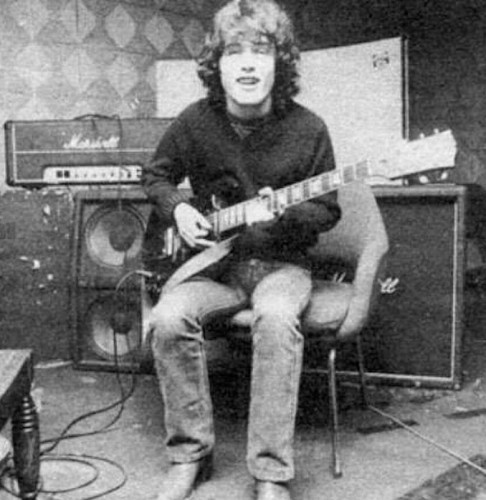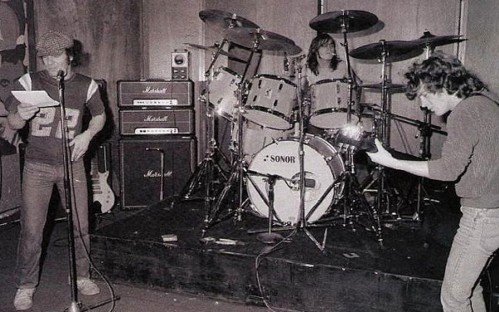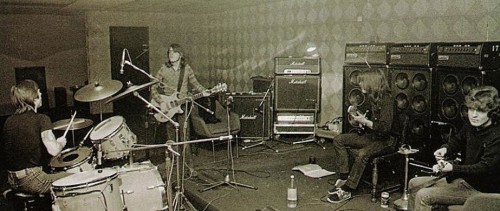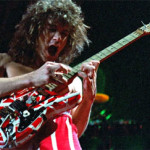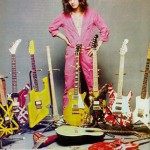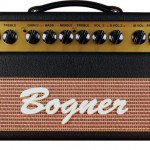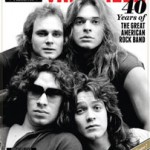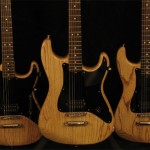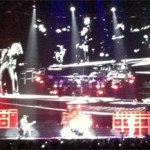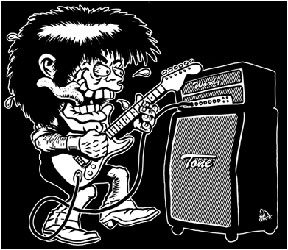More AC/DC Deets: Recording, Amps, Gear
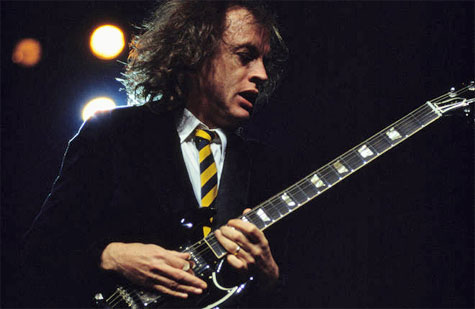
Fascinating stuff. Ran across it when fact-checking the previous post. Enjoy.
Confirming the Boost…
…but only on the solo tracks? Taken from here, remember that Tony Platt was the engineer on Back in Black:
For Angus’ solo tracks (which were overdubbed), Platt employed two stacks, one in the main room and another in a live chamber at the far end of the building. “We used Angus’s radios [wireless] to transmit to these amps,†says Platt. “The radios actually proved to be quite an important part of the sound, as they added some mid bite. I used two Neumann U67s on each cabinet, so I could pan the result where I wanted. And absolutely no compression was used at all.â€
Mid bite, eh? Sounds like a boost and sort of an EQ.
Amps Used on Back in Black
Platt again:
“Really their unique sound is the way they play – I regularly have to point out that even if I did put up the same mics on the same Marshall amp in the same room, it wouldn’t sound the same unless Angus played the guitar too!
“The amps were a collection of modern and vintage Marshalls from 50 watt upwards. I generally find though that the best sound is achieved from the flat front cabinets with the lower wattage speakers [these are 25w Greenbacks]. If the speakers are too capable of handling the power then the crunch isn’t the same.
“Now what do we mean by loud? No they weren’t on ’11’…but the sounds were clear and punchy. The best description I have heard was from my former manager Ralph Simon who called it ‘a clean dirty sound’! I think you need to make sure you can still hear the strings vibrating.”
Amps
For years it’s been assumed that “Angus used JTM45s,” the early Marshalls that were supposed to sound like Fender Bassmans. He probably did use those amps, but there is zero evidence that he favored them for any length of time except for maybe a stretch in the ’90s – in other words, well after Back in Black.
Angus in a 1983 interview, not sure where from:
“Ever since I’ve been in this band I’ve been using Marshalls. I’ve tried Ampeg and they weren’t too good for the sound I wanted.
“On stage I have four stacks going, all hooked up with splitter boxes. 100-watt stacks…it’s good for your eardrums. I use a real lot of volume, I turn that up.
“I turn the Treble and Bass on about half, and [Mids] the same. I don’t use any Presence. If I don’t think it’s putting out enough top, I will kick up the Presence.
“With Marshalls, if you’re using a fair bit of volume, if you whack the Treble and Bass at half, that’s where they’re working.”
And then he says this:
“We go down there [where? Marshall HQ?] and try [the amps] out and fool around with amps, and tell them what we want and they doctor them up.”
Hmmm…. From an interview with Angus and Malcolm in the April 2003 Guitar World:
Malcolm: “In the very early days I was using one of those Marshalls with the small logo on the front. I began using a modified Marshall bass [Super Bass] head that gave me a much bigger and cleaner sound.”
Angus: “For me it was always Marshall 100w Super Leads, I had bought one second-hand in Australia when I was younger. It had a great sound, very bright.”
There’s that modified thing again….
Worth 1,000 Words?
Here you go, pics supposedly from the BIB sessions. Remember that Marshalls with four input holes are non-Master Vol amps while those with two holes do have Master Vols.
More: Platt’s Recording Technique
> Here’s Tony on his two-mic/non-SM57 guitar recording technique, from here:
“Once you have got the sound coming out of the amp that the guitar player wants, the next thing you need to do is to put it into the part of the room that is going to enhance that sound. For example, if you stick that facing into a corner of a room, that sound is going to change and the capacity to capture that sound might be entirely compromised. So you need to choose a place in the room where the sound is going to come out of the amp and allow it to develop to be what it is.
“Then the choice of microphones is the next important step. I am unusual in the fact that though I know a lot of engineers like using dynamic microphones like SM-57s, I prefer instead all condenser microphones. My preferred microphones are Neumann U-67, because I want to capture a lot of the sounds, not just one component of it, and so if you’ve got the sound on the amp right, then that will help.
“And everybody assumes too that it is necessary to crank an amp up to the point where it makes your ears bleed. But you don’t really need to do that because microphones are extremely sensitive pieces of equipment. As long as you get the thing fired up so that it is pumping nicely, then the microphone is going help you do that.
“I use two microphones, preferably on different speakers, because then this allows me to spread the sound in the mix.
> If you’re curious, more on the two-mic technique is here.
Category: AC/DC, Celestion speakers, Marshall, Neumann, Recording techniques

